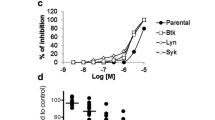Abstract
Purpose
To examine the role of phosphatase inhibition on anti-CD22, HB22.7-mediated lymphomacidal effects.
Experimental design
CD22 is a cell-surface molecule expressed on most B cell lymphomas (NHL). HB22.7 is an anti-CD22 monoclonal antibody that binds a unique CD22-epitope, blocks ligand binding, initiates signaling, and has demonstrated lymphomacidal activity. The SHP-1 tyrosine phosphatase is associated with the cytoplasmic domain of CD22. Sodium orthovanadate (NaV) is a phosphatase inhibitor. The SHP-1-CD22 interaction presents an opportunity to manipulate CD22-mediated signaling effects. In vitro cell culture assays and in vivo human NHL xenograft studies were used to assess the effects of phosphatase inhibition.
Results
NaV caused dose dependent killing of NHL cells in vitro; when HB22.7 was given with NaV, antibody-mediated cell death was augmented. Flow cytometry showed that NaV-pretreatment resulted in less CD22 internalization after ligation with HB22.7 than did control cells. Studies in mice bearing Raji NHL xenografts showed that the combination of NaV and HB22.7 shrank NHL tumors more rapidly, had a higher complete response rate (80%), and produced the best survival compared to controls; no toxicity was detected. Studies using Raji cells stably transfected with SHP-1DN confirmed that these observations were due to SHP-1 inhibition.
Conclusion
The relatively specific association of SHP-1 with CD22 suggests that CD22-specific signal augmentation by phosphatase inhibitors can improve the clinical outcome of anti-CD22 based immunotherapy.






Similar content being viewed by others
References
Siegel AB, Goldenberg DM, Cesano A, Coleman M, Leonard JP (2003) CD22-directed monoclonal antibody therapy for lymphoma. Semin Oncol 30:457–464
Tuscano JM, Engel P, Tedder TF, Agarwal A, Kehrl JH (1996) Involvement of p72syk kinase, p53/56lyn kinase and phosphatidyl inositol-3 kinase in signal transduction via the human B lymphocyte antigen CD22. Eur J Immunol 26:1246–1252
Tuscano JM, Engel P, Tedder TF, Kehrl JH (1996) Engagement of the adhesion receptor CD22 triggers a potent stimulatory signal for B cells and blocking CD22/CD22L interactions impairs T-cell proliferation. Blood 87:4723–4730
Tuscano JM, Riva A, Toscano SN, Tedder TF, Kehrl JH (1999) CD22 cross-linking generates B-cell antigen receptor-independent signals that activate the JNK/SAPK signaling cascade. Blood 94:1–12
Tuscano JM, O’Donnell RT, Miers LA et al (2003) The anti-CD22 ligand blocking antibody, HB22.7, has independent lymphomacidal properties, and augments the efficacy of 90Y-DOTA-peptide-Lym-1 in lymphoma xenografts. Blood 101:3641–3664
O’Donnell RT, Pearson D, McKnight HC, Tedder TF, Tuscano JM (2005) Sodium orthovanadate (NaV) effects CD22 expression, intracellular signaling, and lymphomacidal activity of the HB22.7 anti-CD22 monoclonal antibody. Blood 106:1487 (ASH annual meeting abstracts)
Fujimoto M, Bradney AP, Poe JC, Steeber DA, Tedder TF (1999) Modulation of B lymphocyte antigen receptor signal transduction by a CD19/CD22 regulatory loop. Immunity 11:191–200
Schmidt KN, Hsu CW, Griffin CT, Goodnow CC, Cyster JG (1998) Spontaneous follicular exclusion of SHP1-deficient B cells is conditional on the presence of competitor wild-type B cells. J Exp Med 187:929–937
Poe JC, Hasegawa M, Tedder TF (2001) CD19, CD21, and CD22: multifaceted response regulators of B lymphocyte signal transduction. Int Rev Immunol 20:739–762
Rokhlin OW, Cohen MB (1995) Differential sensitivity of human prostatic cancer cell lines to the effects of protein kinase and phosphatase inhibitors. Cancer Lett 98:103–110
Bergamaschi G, Rosti V, Danova M, Ponchio L, Lucotti C, Cazzola M (1993) Inhibitors of tyrosine phosphorylation induce apoptosis in human leukemic cell lines. Leukemia 7:2012–2020
Nicholas R, Paling D, Welham J (2002) Role of the protein tyrosine phosphatase SHP-1 (Src homology phosphatase-1) in the regulation of interleukin-3-induced survival, proliferation and signaling. Biochem J 368:885–894
Paling NR, Welham MJ (2005) Tyrosine phosphatase SHP-1 acts at different stages of development to regulate hematopoiesis. Blood 105:4290–4297
Bertolini F, Fusetti L, Mancuso P et al (1999) Endostatin, an antiangiogenic drug, induces tumor stabilization after chemotherapy or anti-CD20 therapy in a NOD/SCID mouse model of human high-grade non-Hodgkin lymphoma. Blood 96:282–287
Yohannan J, Wienands J, Coggeshall KM, Justement LB (1999) Analysis of tyrosine phosphorylation-dependent interactions between stimulatory effector proteins and the B cell co-receptor CD22. J Biol Chem 274:18769–18776
Pathak MK, Yi T (2001) Effects of sodium stibogluconate on differentiation and proliferation of human myeloid leukemia cell lines in vitro. J Immunol 167:3391–3398
Umezawa K, Kawakami M, Watanabe T (2003) Molecular design and biological activities of protein-tyrosine phosphatase inhibitors. Pharmacol Ther 99:15–21
Engel P, Wagner N, Miller AS, Tedder TF (1995) Identification of the ligand-binding domains of CD22, a member of the immunoglobulin superfamily that uniquely binds a sialic acid-dependent ligand. J Exp Med 181:1581–1586
Leonard JP, Link BK (2002) Immunotherapy of non-Hodgkin’s lymphoma with hLL2 (epratuzumab, an anti-CD22 monoclonal antibody) and Hu1D10 (apolizumab). Semin Oncol 29:81–86
Stein R, Belisle E, Hansen HJ, Goldenberg DM (1993) Epitope specificity of the anti-(B cell lymphoma) monoclonal antibody, LL2. Cancer Immunol Immunother 37:293–298
Carnahan J, Wang P, Kendall R et al (2003) Epratuzumab, a humanized monoclonal antibody targeting CD22: characterization of in vitro properties. Clin Cancer Res 9:3982S–3990S
Leonard JP, Coleman M, Ketas JC et al (2003) Phase I/II trial of epratuzumab (humanized anti-CD22 antibody) in indolent non-Hodgkin’s lymphoma. J Clin Oncol 21:3051–3059
Poe JC, Fujimoto Y, Haesegawa M et al (2004) CD22 regulates B lymphocyte function in vivo through both ligand-dependent and ligand-independent mechanisms. Nat Immunol 5:1078–1087
Hass KM, Suman S, Sanford IG et al (2006) CD22 ligand binding regulates normal and malignant B lymphocyte survival in vivo. J Immunol 177:3063–3073
Acknowledgments
This work was supported in part by Veterans Administration Merit Award, Leukemia and Lymphoma Society Translational Research Award, UC Davis Health Sciences Grant, the DeLeuze Endowment for the Non-Toxic Cure of Lymphoma, and the Schwedler Family Foundation.
Conflict of interest
The authors report no competing financial interests.
Author information
Authors and Affiliations
Corresponding author
Rights and permissions
About this article
Cite this article
O’Donnell, R.T., Pearson, D., McKnight, H.C. et al. Treatment of non-Hodgkin’s lymphoma xenografts with the HB22.7 anti-CD22 monoclonal antibody and phosphatase inhibitors improves efficacy. Cancer Immunol Immunother 58, 1715–1722 (2009). https://doi.org/10.1007/s00262-009-0688-5
Received:
Accepted:
Published:
Issue Date:
DOI: https://doi.org/10.1007/s00262-009-0688-5




